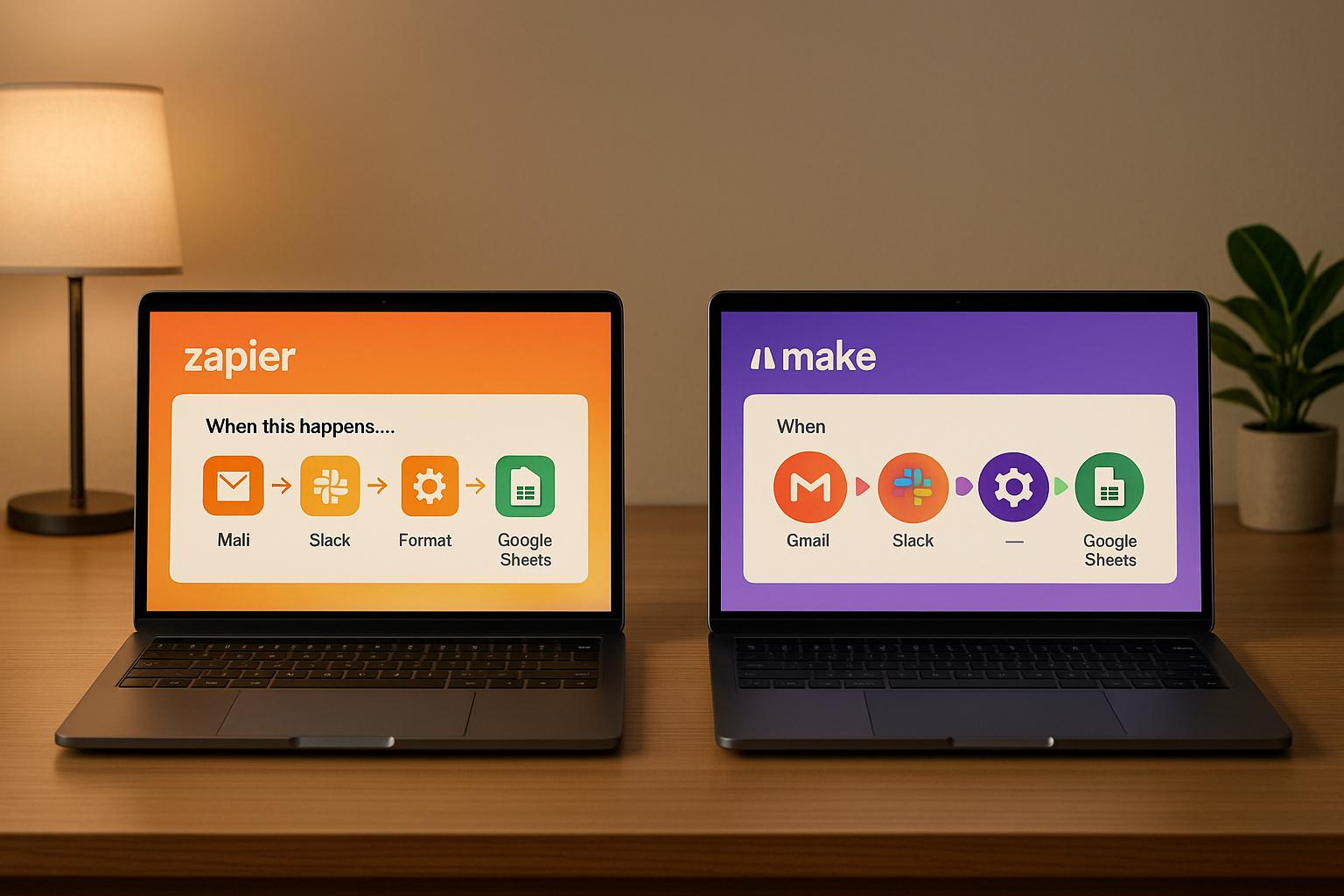AI tools are transforming email marketing by automating tasks like segmentation, personalization, and scheduling. From small businesses to enterprises, these platforms help optimize campaigns, improve engagement, and save time. This article reviews 15 AI-powered email marketing tools, comparing features like automation, predictive analytics, ease of use, pricing, and support.
Key Highlights:
- AI Apps: A free directory with 1,000+ AI tools for marketers to explore and compare.
- Twilio SendGrid: Reliable for high-volume email infrastructure with AI-powered analytics.
- Mailchimp: Beginner-friendly with predictive send times and basic automation.
- Constant Contact: Simple for small businesses, offering segmentation and event tools.
- ActiveCampaign: Advanced automation and CRM for businesses ready to scale.
- MailerLite: Affordable, user-friendly platform with solid automation.
- GetResponse: Combines email marketing with webinars and e-commerce tools.
- Optimove: Data-driven platform for lifecycle marketing and predictive analytics.
- Kit (formerly ConvertKit): Tailored for creators with easy workflows.
- Rasa: Open-source conversational AI for custom chatbots and assistants.
- Mailmodo: Interactive emails for higher engagement and conversions.
- Zeta: Multi-channel marketing cloud for personalized customer journeys.
- Jasper: AI-powered email content creation for high-volume campaigns.
- Brevo: All-in-one platform with email, SMS, and CRM features.
- Encharge: Behavior-driven automation for tailored workflows.
Quick Comparison
| Tool | Starting Price | Free Plan | Best For | Key Limitation |
|---|---|---|---|---|
| AI Apps | Free | Yes | Tool discovery | Not an email platform |
| Twilio SendGrid | Free | Yes | High-volume email sending | Limited design tools |
| Mailchimp | Free | Yes | Small businesses | Costs rise with list growth |
| Constant Contact | $12/month | No | Small businesses | Basic automation |
| ActiveCampaign | $29/month | No | Advanced marketers | Steep learning curve |
| MailerLite | Free | Yes | Beginners | Basic AI features |
| GetResponse | $19/month | No | E-commerce | Complex interface |
| Optimove | $5,000/month | No | Enterprise-level marketing | High cost |
| Kit | Free | Yes | Creators | Limited advanced features |
| Rasa | Free | Yes | Developers | Requires technical expertise |
| Mailmodo | $39/month | No | Interactive email campaigns | Learning curve |
| Zeta | $2,000/month | No | Enterprise-level marketing | High cost |
| Jasper | $39/month | No | Content creation | No email delivery |
| Brevo | Free | Yes | All-in-one communication | Limited free sends |
| Encharge | $79/month | No | SaaS companies | No free plan |
Choose the right tool based on your business size, budget, and marketing goals. Whether you're a small business owner or an enterprise marketer, this guide will help you find the best platform for your needs.
Best AI Tools for Email Marketing – But Watch Out for These Traps!
1. AI Apps
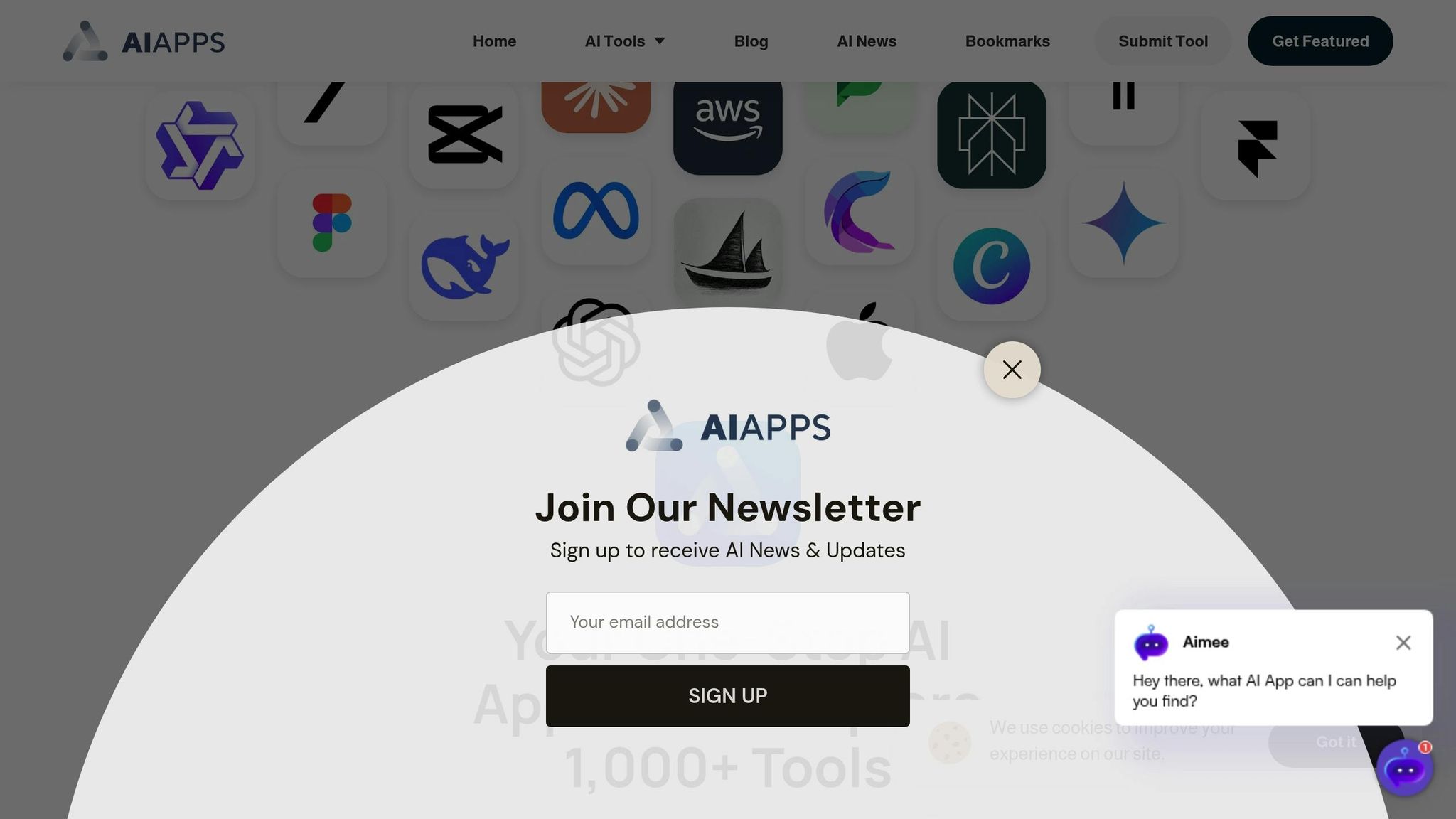
AI Apps is a platform designed to help marketers discover AI-driven email marketing tools. While it’s not an email marketing solution itself, it serves as a comprehensive directory with over 1,000 AI tools across various categories. This makes it a go-to resource for exploring, comparing, and selecting the right tools tailored to specific marketing needs.
AI Features
AI Apps offers advanced filtering options, making it easier for users to navigate its extensive collection. You can filter tools by category, sub-category, or pricing model, helping you quickly zero in on the best fit for your email marketing strategy. Featured and newly launched tools are also highlighted for added convenience.
To maintain quality, AI Apps uses a rigorous verification process to screen the tools listed on the platform. This ensures that every tool meets certain standards, saving marketers the effort of independently researching and vetting options. The result? A more efficient way to discover tools that enhance email marketing through personalization and automation.
Pricing
The platform operates on a freemium model, making it free for users to access and explore its directory of AI tools. Developers can list their tools for free, but those seeking extra visibility can opt for paid featured listings. These premium placements include homepage visibility, top spots in relevant categories, and enhanced visual features.
For marketers, this means free access to a vast array of AI email marketing tools without any subscription fees. You can browse and evaluate solutions without incurring additional costs.
Target Users
AI Apps caters to a variety of users, including small business owners, marketing managers, agencies, startup founders, and consultants:
- Small business owners benefit from discovering affordable, easy-to-use tools that can automate campaigns without requiring technical expertise.
- Marketing managers at mid-sized companies use the platform to compare advanced tools offering features like segmentation and personalization.
- Digital marketing agencies value the directory for its ability to quickly identify specialized tools tailored to diverse client needs.
- Startup founders rely on AI Apps to evaluate multiple tools before committing to a specific solution for their marketing stack.
- Marketing consultants use the platform to stay up-to-date on emerging tools, ensuring they provide informed recommendations to their clients.
Strengths and Weaknesses
| Strengths | Weaknesses |
|---|---|
| Curated, verified listings with advanced filters save time | No tool testing available directly on the platform |
| Free access to the directory for users | Limited integration - discovery only, not implementation |
| Regular updates with new tools | Relies on developer submissions for tool variety |
| Quality verification ensures reliable listings | No unified pricing comparison across tools |
| Extensive directory with 1,000+ tools | Additional research needed for detailed feature comparisons |
AI Apps also features a blog section that provides insights into AI trends and tool updates. This helps users stay informed about the latest developments in email marketing technology. However, for detailed pricing, feature breakdowns, or trial options, users will need to visit individual tool websites.
Next, let’s dive into Twilio SendGrid’s AI capabilities.
2. Twilio SendGrid
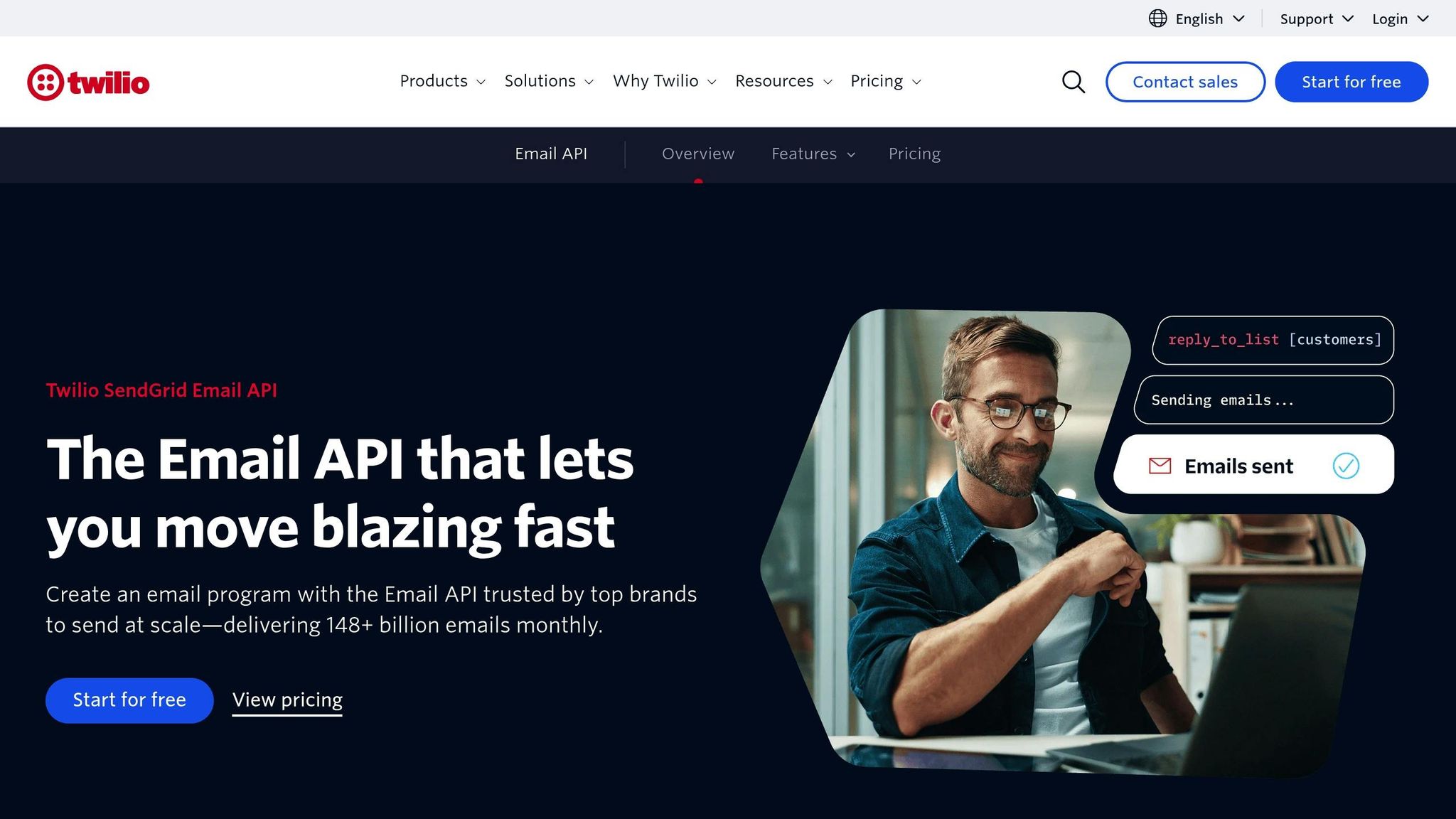
Twilio SendGrid is a cloud-based email platform that leverages AI to enhance email campaigns. Known for managing large-scale email volumes worldwide, it’s a go-to choice for businesses needing reliable email infrastructure.
AI Features
SendGrid integrates machine learning to optimize email performance in several ways. One standout feature is Send Time Optimization, which uses predictive analytics to analyze recipient behavior. By examining historical data on opens and clicks, it determines the best time to send emails for maximum engagement.
The platform also offers AI-powered deliverability insights, analyzing factors like bounce rates, spam complaints, and engagement metrics. These insights help users make data-driven adjustments to improve email success rates. Additionally, SendGrid simplifies experimentation with automated A/B testing. It tests variations in subject lines, content, and send times, using machine learning to identify the most effective combinations - no manual effort required. These capabilities, combined with flexible pricing options, make it appealing to a range of businesses.
Pricing
SendGrid offers a tiered, pay-as-you-go pricing model. For those just starting out, the free tier includes basic sending limits. Advanced plans unlock features like Send Time Optimization, higher sending capacities, and additional tools. Premium plans cater to larger businesses, offering dedicated IP addresses, advanced analytics, and priority customer support. Custom pricing is available for enterprise-level needs.
Target Users
SendGrid is tailored for developers, SaaS companies, and large enterprises that depend on a reliable email infrastructure. Its API-driven email sending makes it especially popular among tech companies.
E-commerce businesses use SendGrid for transactional emails like order confirmations and shipping updates, as well as marketing campaigns. Marketing teams at mid- to large-sized organizations benefit from its AI tools to improve campaign performance and email deliverability.
Additionally, email service providers and marketing agencies often rely on SendGrid’s robust API and webhook capabilities to create custom email solutions that integrate seamlessly with existing systems.
Strengths and Weaknesses
| Strengths | Weaknesses |
|---|---|
| Reliable deliverability and excellent uptime | Limited email design tools compared to marketing-specific platforms |
| Powerful API for easy integration | Steep learning curve for beginners |
| Advanced analytics and real-time tracking | AI features only available on higher-tier plans |
| Scalable infrastructure for handling large email volumes | Slower customer support on lower-tier plans |
| Compliance tools for regulations like GDPR and CAN-SPAM | Template library lacks depth compared to design-focused platforms |
Next, let’s dive deeper into how SendGrid’s infrastructure supports developers and enterprises.
3. Mailchimp
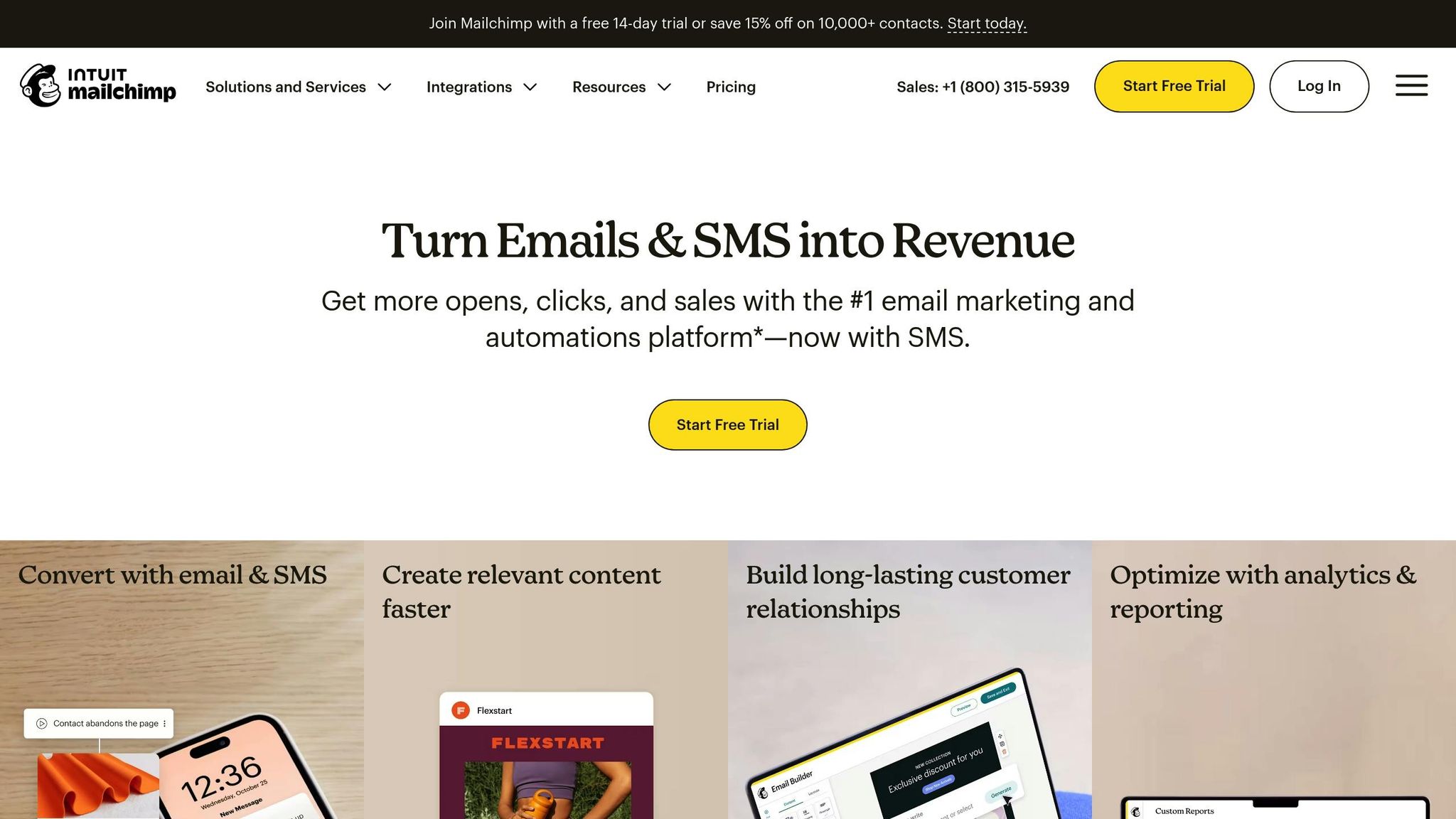
Mailchimp has grown into a robust platform that leverages automation and machine learning to fine-tune email campaigns. Trusted by millions worldwide, it combines an easy-to-navigate interface with smart tools designed to analyze subscriber behavior and boost campaign effectiveness.
AI Features
Mailchimp’s AI-powered tools are tailored to enhance email marketing outcomes. Using its Customer Journey Builder, the platform tracks subscriber actions - like website visits, purchase history, and email interactions - to send timely and personalized messages. Another standout feature is send time optimization, which identifies the ideal time to send emails based on past engagement patterns, ensuring better open and click-through rates.
Pricing
Mailchimp operates on a freemium model, making it accessible to businesses of all sizes. The free plan offers basic automation for smaller contact lists, while paid plans unlock features like A/B testing, advanced targeting, and segmentation. This tiered pricing makes it a popular choice for small businesses and agencies looking for scalable solutions without hefty upfront costs.
Target Users
Mailchimp is designed with small to medium-sized businesses in mind. Here’s how different users benefit:
- E-commerce businesses use its automation and personalization tools to run targeted promotions.
- Bloggers appreciate its straightforward interface for managing newsletters.
- Agencies value its multi-user collaboration features and in-depth reporting capabilities.
Strengths and Weaknesses
| Strengths | Weaknesses |
|---|---|
| Easy-to-use drag-and-drop email builder | Advanced features are locked behind higher-tier plans |
| Robust automation workflows | Costs can rise quickly as contact lists expand |
| Extensive integrations with third-party tools | Limited customization options for advanced users |
| Detailed analytics for tracking performance | Customer support can vary depending on the plan tier |
| Mobile-friendly templates with preview tools | Some automation features require a significant amount of historical data |
Mailchimp’s primary appeal lies in its ability to simplify complex email marketing tasks, making it approachable for a wide range of businesses. However, as subscriber lists grow, the pricing and limited access to advanced tools may pose challenges for scaling companies.
Up next, we’ll take a closer look at Constant Contact to see how it stacks up in the world of AI-powered email marketing platforms.
4. Constant Contact
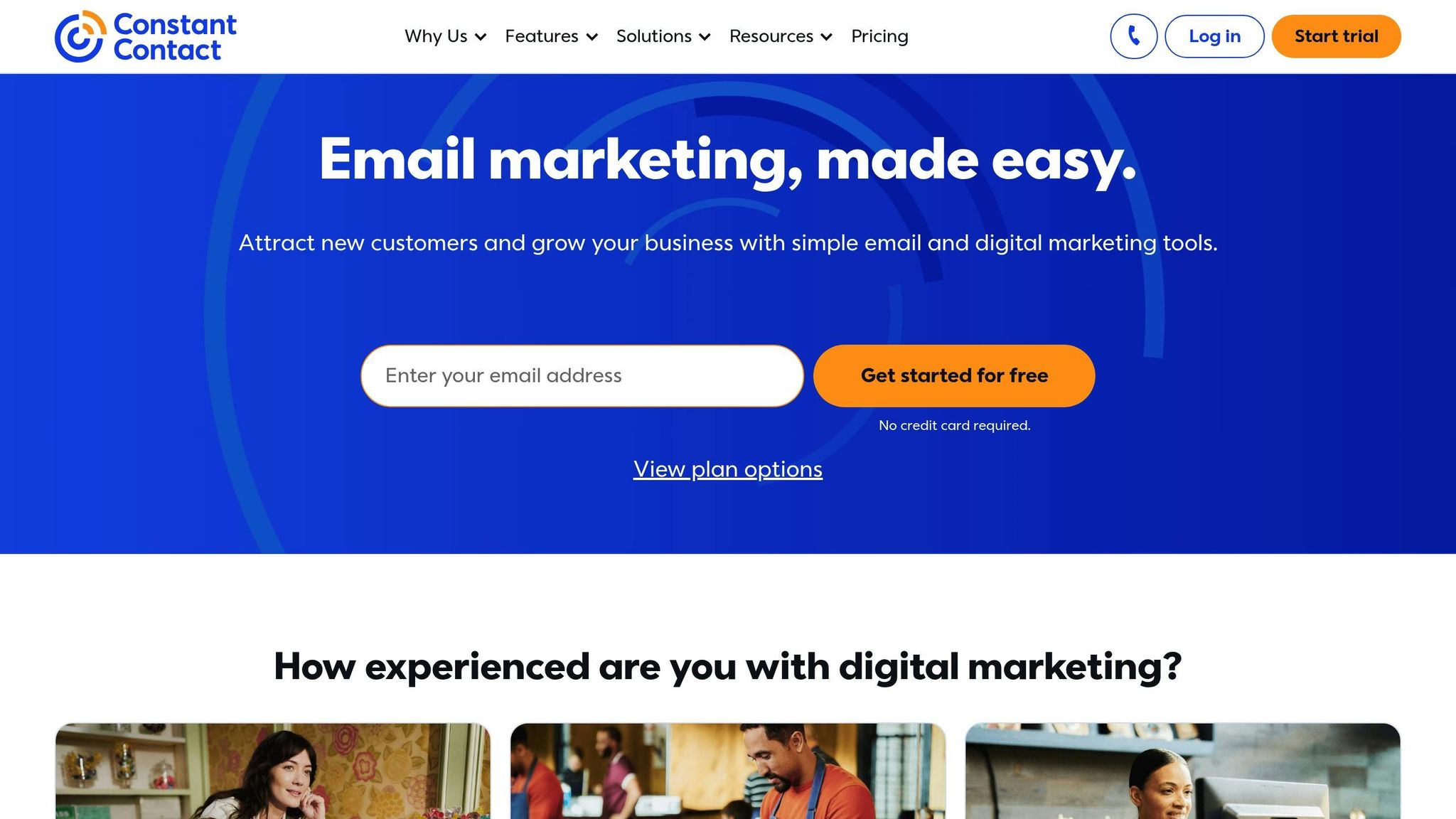
Constant Contact provides a straightforward platform tailored for small businesses and nonprofits. Its growing AI-driven features simplify campaign management and personalization, making it accessible even for those without technical expertise.
Automation & Personalization Features
Constant Contact includes tools designed to streamline email marketing. For example, it can segment audiences using engagement metrics and demographic data, allowing for more precise targeting. Its automated Welcome Series ensures new subscribers receive a sequence of introductory emails promptly, fostering early engagement. Additionally, the platform supports A/B testing for subject lines and offers insights to optimize send times based on subscriber behavior. While helpful, these features are relatively basic when compared to more advanced AI-driven platforms.
Pricing
The pricing structure for Constant Contact is based on the size of your contact list, with tiered plans offering more features as you move up. The entry-level plan includes essential email marketing and automation tools, while higher-tier plans add features like behavioral targeting and advanced A/B testing. All plans allow unlimited email sends, and there’s a generous free trial period, giving users ample time to explore the platform before making a decision.
Target Users
Constant Contact is a great fit for small businesses, nonprofits, and local organizations that value simplicity and reliable customer support. Its integrations with e-commerce platforms make it a practical choice for retail businesses, while service-based organizations can take advantage of its event management tools. Nonprofits, in particular, appreciate the platform’s ease of use and discounted pricing, which help them run campaigns efficiently without needing advanced technical skills.
Strengths and Weaknesses
| Strengths | Weaknesses |
|---|---|
| Excellent customer support with live chat and phone options | Limited advanced automation compared to enterprise-level tools |
| Generous free trial period | Fewer third-party integrations compared to larger platforms |
| Includes event management and social media tools | Analytics and reporting are fairly basic |
| No additional fee to remove branding | Limited options for customizing templates |
| High deliverability rates and compliance features | Automation lacks sophistication compared to specialized AI platforms |
Constant Contact’s user-friendly design and dependable support make it a solid choice for organizations that prioritize ease of use. However, businesses seeking more advanced automation and deeper personalization features might find its capabilities somewhat limited. This platform is a reliable entry point, but it may not meet the demands of users with more complex needs.
Next, we’ll take a closer look at ActiveCampaign and how its advanced automation capabilities stand out in the AI email marketing landscape.
5. ActiveCampaign
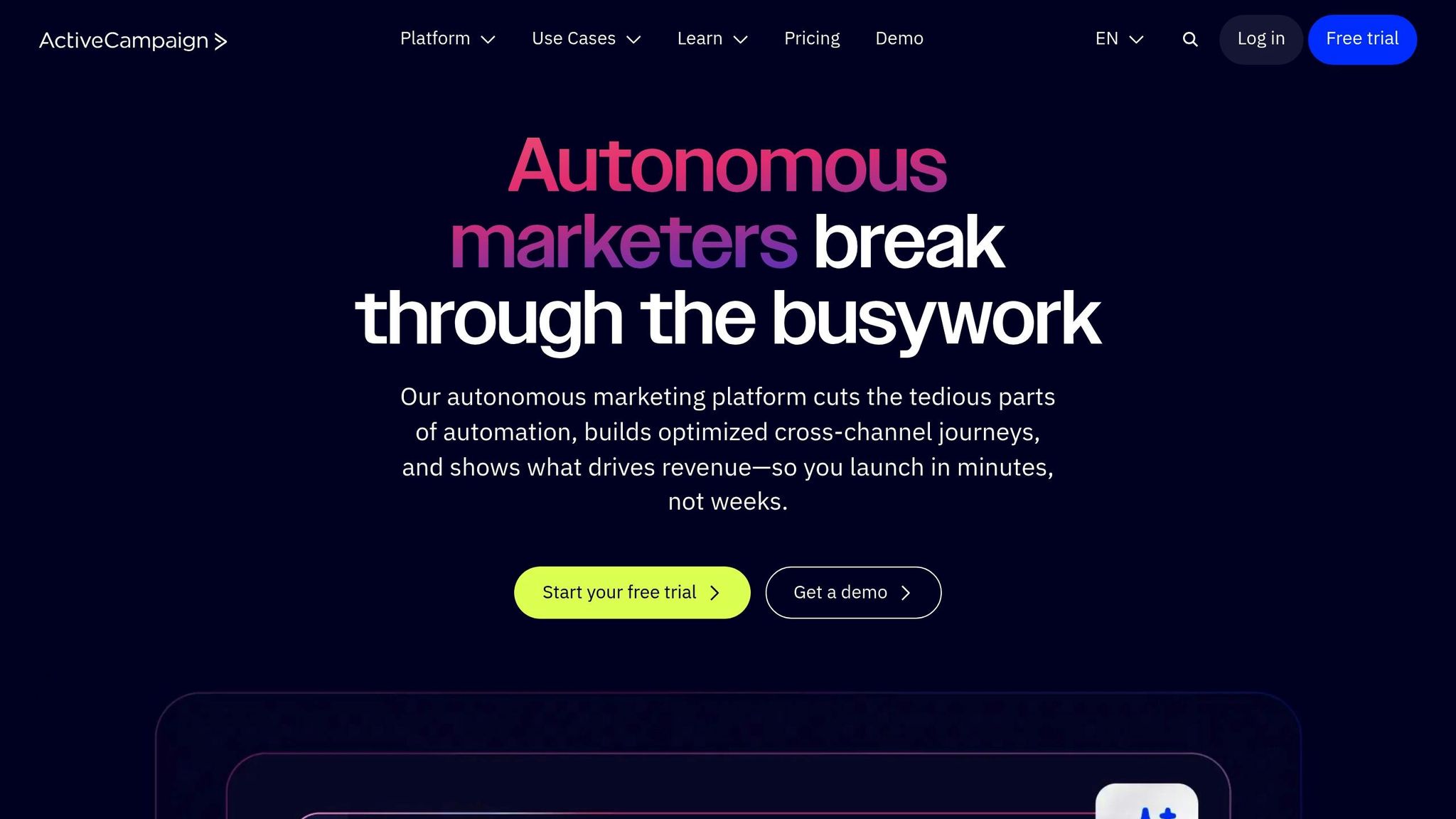
ActiveCampaign combines advanced automation with CRM tools, making it a standout choice for email marketing. It’s particularly well-suited for businesses that need powerful workflows and seamless CRM integration.
AI Features
One of ActiveCampaign’s standout features is predictive sending, available in the Pro plan. This AI-powered tool helps boost engagement by timing emails to land in inboxes when recipients are most likely to interact. For users on higher-tier plans, the platform allows for highly detailed automation workflows that adapt based on subscriber behavior, creating a more personalized experience.
Pricing
ActiveCampaign’s pricing depends on the size of your contact list and the features you need. For 1,000 contacts, annual plans start at $15/month for the Starter plan and go up to $145/month for the Enterprise plan. Monthly billing rates are slightly higher, ranging from $19 to $179.
For 10,000 contacts, prices range from $149 to $589 annually, or $189 to $739 with monthly billing. The Starter plan provides basic email marketing but limits automation to five steps and lacks conditional logic. The Plus plan, priced at $49/month, is often the true entry-level option, unlocking unlimited automation steps, basic CRM tools, and landing page creation. The Pro plan adds advanced features like predictive sending, A/B testing for workflows, and in-depth reporting.
However, features such as SMS marketing, advanced CRM pipelines, and transactional emails require additional purchases, which can significantly increase monthly costs. Even the built-in CRM remains fairly basic unless you invest in pipeline and sales engagement add-ons. This tiered pricing structure reflects ActiveCampaign’s focus on delivering scalable tools for growing businesses.
Target Users
ActiveCampaign is ideal for businesses that need sophisticated automation. It’s particularly useful for B2B SaaS companies, e-commerce brands, and organizations with longer sales cycles that require consistent engagement across multiple touchpoints.
The platform integrates seamlessly with tools like Shopify, WordPress, and Salesforce, making it an excellent option for businesses with established tech stacks. For marketing teams looking to combine email marketing with CRM capabilities, ActiveCampaign offers a compelling solution - though unlocking its full potential often requires additional investment.
Strengths and Weaknesses
| Strengths | Weaknesses |
|---|---|
| Advanced automation with unlimited steps in higher-tier plans | Costs rise quickly with contact list growth |
| Sophisticated segmentation and behavioral targeting | Many essential features require costly add-ons |
| Built-in CRM functionality | CRM is limited without pipeline upgrades |
| Strong third-party integrations | Steep learning curve for new users |
| Comprehensive reporting and analytics | Starter plan lacks key features |
| A/B testing for automation workflows | Can become expensive for larger lists |
With its rich feature set, ActiveCampaign is a strong choice for businesses ready to invest in advanced email marketing tools. It’s designed to meet the needs of companies that value automation and are prepared to scale.
Next, we’ll take a closer look at MailerLite, a platform known for its simplicity and affordability, which appeals to small businesses and creators.
6. MailerLite
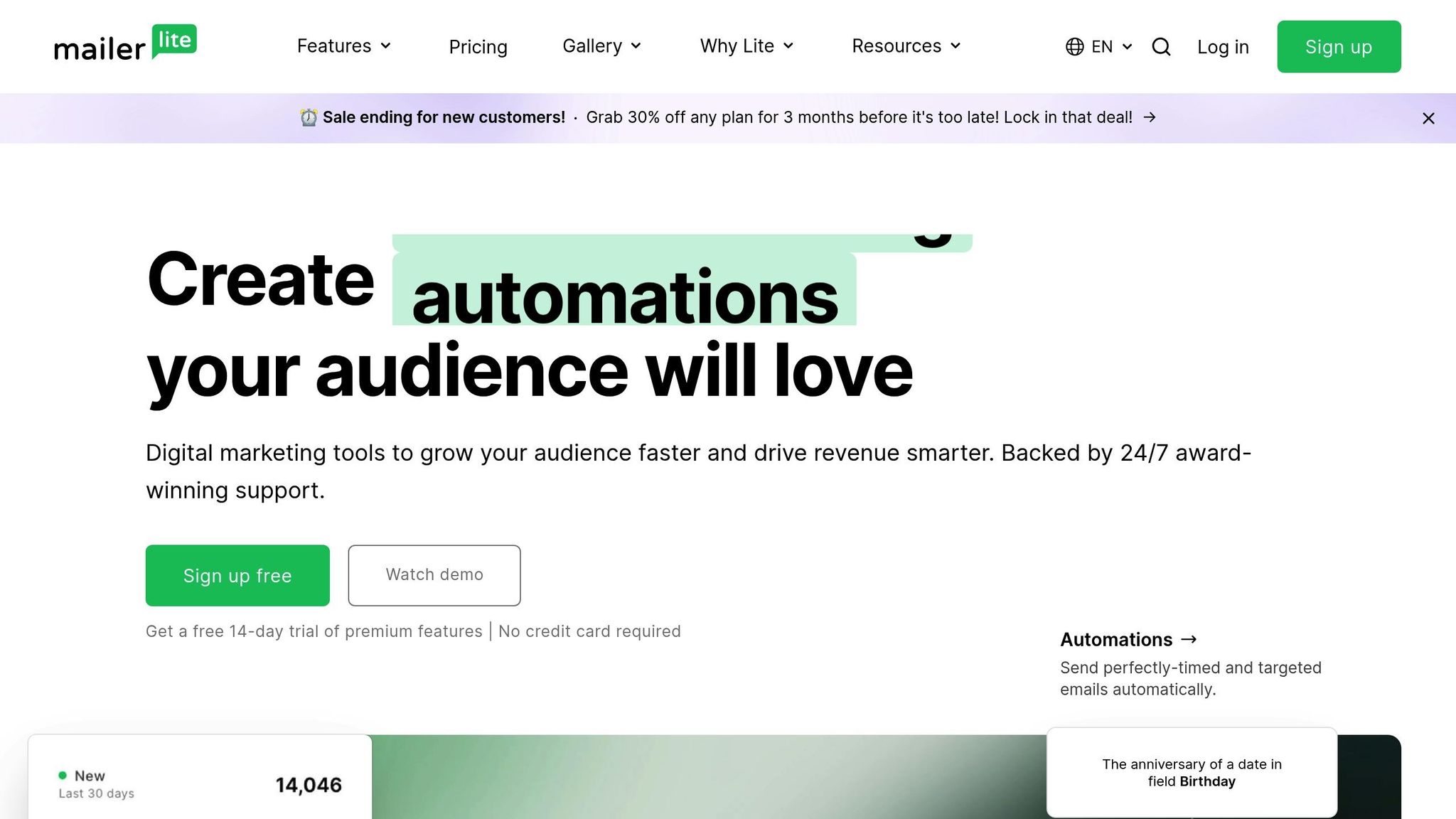
MailerLite is a straightforward platform tailored for small businesses, creators, and entrepreneurs. It delivers effective automation tools without burdening users with overly complex enterprise-level features.
While MailerLite includes solid automation and segmentation capabilities, its real strength lies in its simplicity and user-friendly design, rather than an emphasis on cutting-edge AI integrations.
Pricing
MailerLite’s Free plan is perfect for startups, allowing up to 1,000 subscribers and 12,000 monthly emails.
For those needing more, paid plans start at $10/month for 1,000 subscribers, $30/month for 5,000, and $50/month for 10,000 subscribers. The pricing structure is refreshingly clear - with no hidden fees or restrictions based on the tier you choose.
Unlike many competitors, MailerLite doesn’t charge extra for features like automation, landing pages, or detailed analytics. Paid plans also include access to A/B testing and advanced segmentation tools, ensuring you get the most out of your campaigns.
Target Users
MailerLite is a great fit for small to medium-sized businesses, bloggers, and e-commerce stores looking for an easy-to-use email marketing solution. It’s especially appealing to teams with limited technical expertise or those transitioning from more basic tools.
The platform shines for businesses managing subscriber lists under 50,000. It offers an excellent balance of functionality and affordability, making it a reliable choice for companies in growth mode.
Strengths and Weaknesses
| Strengths | Weaknesses |
|---|---|
| Generous free plan (1,000 subscribers) | Limited CRM features compared to enterprise-level tools |
| Easy-to-use drag-and-drop email editor | Fewer third-party integrations than larger platforms |
| All features included in paid plans | Basic reporting lacks depth compared to advanced analytics tools |
| High deliverability rates | Limited phone support availability |
| Built-in landing page creator | Automation workflows are less advanced than premium options |
| Responsive customer support | No built-in social media management tools |
MailerLite strikes a great balance between affordability and functionality, offering everything most small businesses need for professional email marketing. Its focus on simplicity ensures that users can achieve professional results without the learning curve of more complex platforms.
Next, we’ll dive into GetResponse, a platform that combines email marketing with broader automation and webinar tools.
7. GetResponse
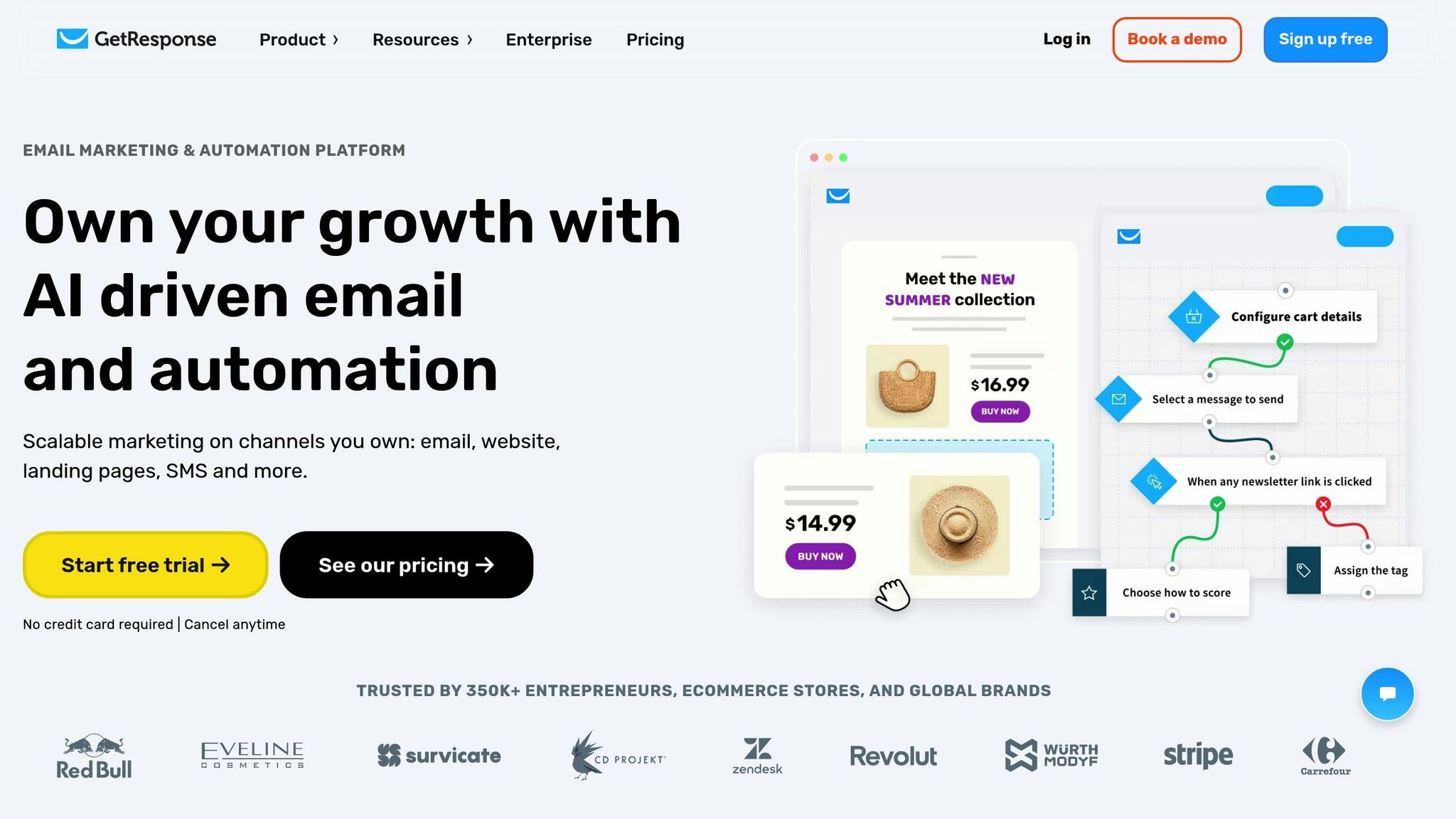
GetResponse is a versatile marketing platform that combines email automation, webinar hosting, landing page creation, and e-commerce tools, offering a one-stop solution for marketers seeking efficiency.
What sets GetResponse apart is its focus on boosting conversions and its multi-channel marketing capabilities. Notably, it includes built-in webinar functionality - something you rarely find in email marketing platforms - allowing seamless integration of live webinars with email campaigns.
AI Features
GetResponse incorporates AI to make email marketing smarter and more effective. Its Email Creator generates industry-specific content, including subject lines, email copy, and even suggests the best times to send messages.
The Perfect Timing feature takes it a step further by using machine learning to figure out when each subscriber is most likely to open their emails. This ensures your messages land in their inbox at just the right moment, increasing open rates.
For e-commerce businesses, GetResponse offers AI-powered product recommendations. By analyzing customer behavior and purchase history, the platform automatically includes personalized product suggestions in emails, helping businesses drive more sales through tailored content.
Pricing
GetResponse provides a 30-day free trial, giving users a chance to explore most of its features before committing.
- The Email Marketing plan starts at $19/month for 1,000 contacts. It includes unlimited emails, autoresponders, and basic segmentation.
- The Marketing Automation plan, priced at $59/month for the same contact limit, adds advanced automation workflows, webinars for up to 100 attendees, and contact scoring.
- For larger needs, the E-commerce Marketing plan costs $119/month and includes advanced e-commerce tools, unlimited webinar attendees, and web push notifications.
- Custom Max plans are available for businesses requiring dedicated support, deliverability consulting, and single sign-on options.
All paid plans come with 24/7 live chat support and phone support during business hours.
Target Users
GetResponse is particularly well-suited for small to medium-sized businesses looking to combine email marketing with webinar hosting and landing page creation. It’s a great fit for coaches, consultants, and online educators who frequently host webinars as part of their strategy.
E-commerce businesses can take advantage of features like shopping cart abandonment sequences and product recommendations. The platform integrates smoothly with popular e-commerce tools like Shopify, WooCommerce, and Magento.
For marketing agencies, GetResponse offers white-label options and detailed reporting tools, making it easier to manage multiple client accounts and streamline communication.
Strengths and Weaknesses
| Strengths | Weaknesses |
|---|---|
| Built-in webinar hosting (rare feature) | Higher cost compared to basic email tools |
| Comprehensive landing page builder with templates | Steeper learning curve for advanced automation |
| Strong e-commerce integrations | Limited webinar branding customization |
| 24/7 customer support on all plans | Free trial requires a credit card |
| Advanced automation workflows with visual builder | Mobile app lacks some desktop features |
| High deliverability rates and ISP monitoring | Template designs could use a modern refresh |
GetResponse shines when you need a platform that goes beyond basic email marketing. Its blend of email automation, webinar hosting, and e-commerce tools makes it a practical choice for businesses aiming to streamline their marketing efforts.
Next, we dive into Optimove's data-driven approach to customer marketing automation.
8. Optimove
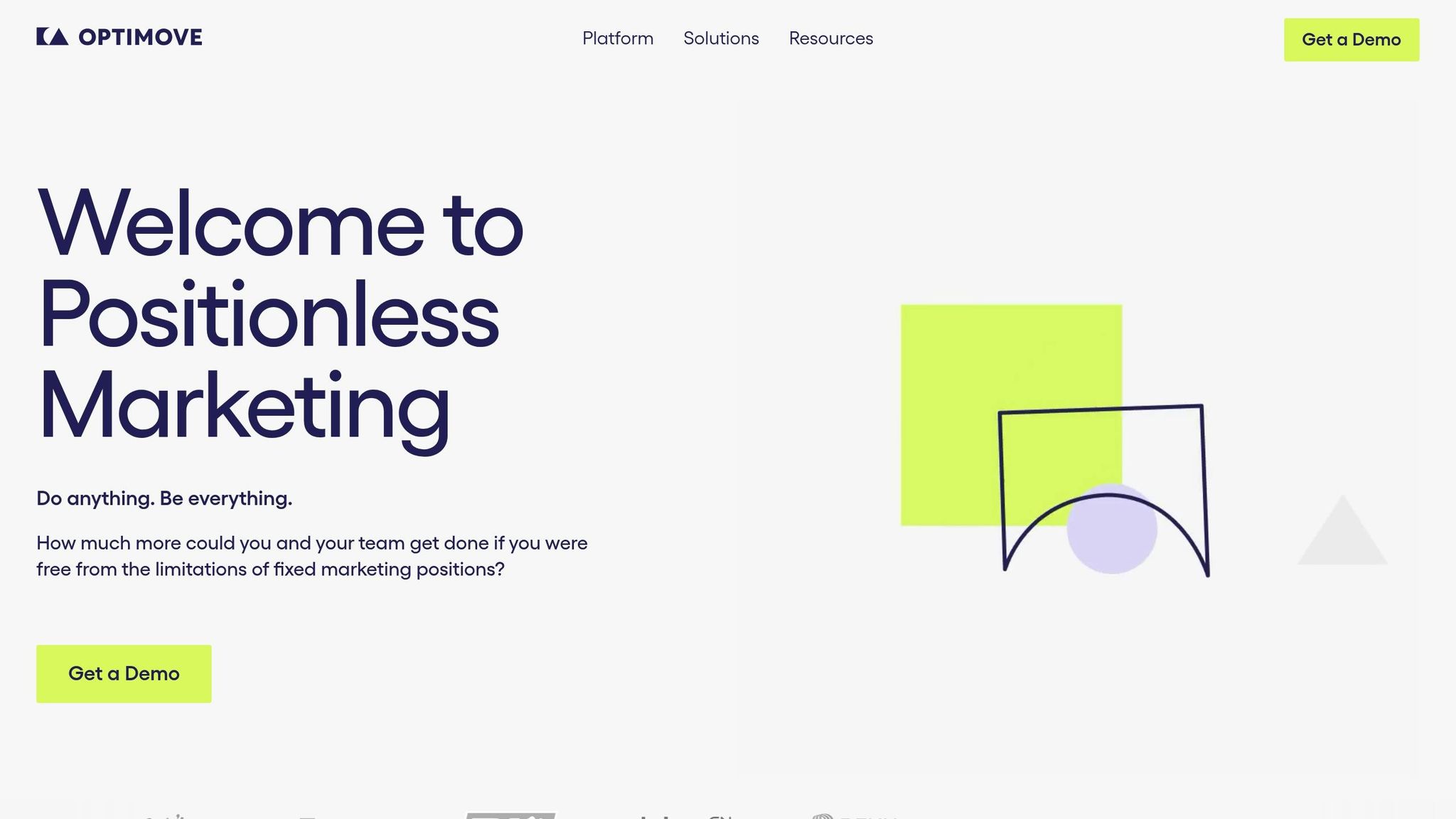
Optimove is a platform that uses data science to turn customer data into highly targeted marketing campaigns. Unlike standard email marketing tools, it prioritizes predictive analytics and customer lifecycle optimization, making it ideal for businesses aiming to build smarter, data-driven customer journeys.
What sets Optimove apart is its blend of advanced machine learning and multi-channel campaign orchestration. It's designed for companies that want to go beyond generic email blasts and instead create campaigns that adapt to individual customer behaviors.
AI Features
Optimove's AI capabilities are built to predict customer lifetime value, churn risk, and key actions, all while fine-tuning campaigns for better results.
At the heart of the platform is the Opti-X AI engine, which identifies the most effective marketing actions for each customer segment. By analyzing historical data, it determines the best mix of campaigns, channels, and timing to maximize engagement and conversions. As the system learns from past performance, its recommendations become increasingly refined.
Another standout feature is real-time decisioning. For example, if a customer abandons a cart or completes a purchase, Optimove's AI instantly triggers the next best action - whether it’s a personalized email, SMS, or another channel.
The platform also offers dynamic segmentation, grouping customers based on behavior, purchase history, and predicted actions. These segments update in real time as customer behavior evolves, ensuring campaigns are always relevant and timely.
This sophisticated AI-driven approach makes Optimove a powerful tool for businesses looking to create personalized, data-informed marketing strategies.
Pricing
Optimove provides custom pricing, tailored to factors like the size of your customer database, the complexity of your data, and the features you need.
- Starting cost: Around $5,000 per month for mid-market companies with sizable customer databases. This includes predictive analytics, multi-channel campaign management, and basic integrations.
- Enterprise plans: Range from $15,000 to $50,000+ per month, depending on data volume, advanced AI features, and the level of professional services required.
A 12-month commitment is mandatory, and the package includes dedicated customer success management, technical support, and regular optimization reviews.
Target Users
Optimove is designed for businesses that want to harness deep customer insights. It’s best suited for mid-market to enterprise-level companies with at least 50,000 active customers. Industries like retail, e-commerce, gaming, and subscription services find the platform particularly valuable for improving customer lifetime value.
- E-commerce retailers can use features like predictive inventory suggestions and automated campaigns to re-engage at-risk customers.
- Gaming and entertainment companies benefit from churn prediction models that identify players likely to disengage, triggering timely re-engagement campaigns.
- Subscription-based businesses rely on lifecycle optimization tools to reduce churn, encourage upgrades, and boost lifetime value with well-timed offers and communications.
Strengths and Weaknesses
| Strengths | Weaknesses |
|---|---|
| Advanced predictive analytics and AI tools | High cost, making it less accessible for smaller businesses |
| Real-time decision-making for campaigns | Complex setup that demands technical expertise |
| Multi-channel campaign management | Requires a large customer database to function effectively |
| Dedicated customer support and optimization services | Lengthy implementation process (3-6 months) |
| Strong ROI tracking and attribution | Limited self-service options for creating campaigns |
| Excellent for improving customer lifetime value | Needs clean and well-organized customer data |
Optimove works best for businesses with large, complex customer data sets. It’s not just a tool for basic email marketing - it’s a platform for companies ready to invest in advanced, data-driven automation to elevate their marketing efforts.
Next, we’ll dive into Kit (formerly ConvertKit) and its tailored approach to email marketing for creators.
sbb-itb-212c9ea
9. Kit (formerly ConvertKit)
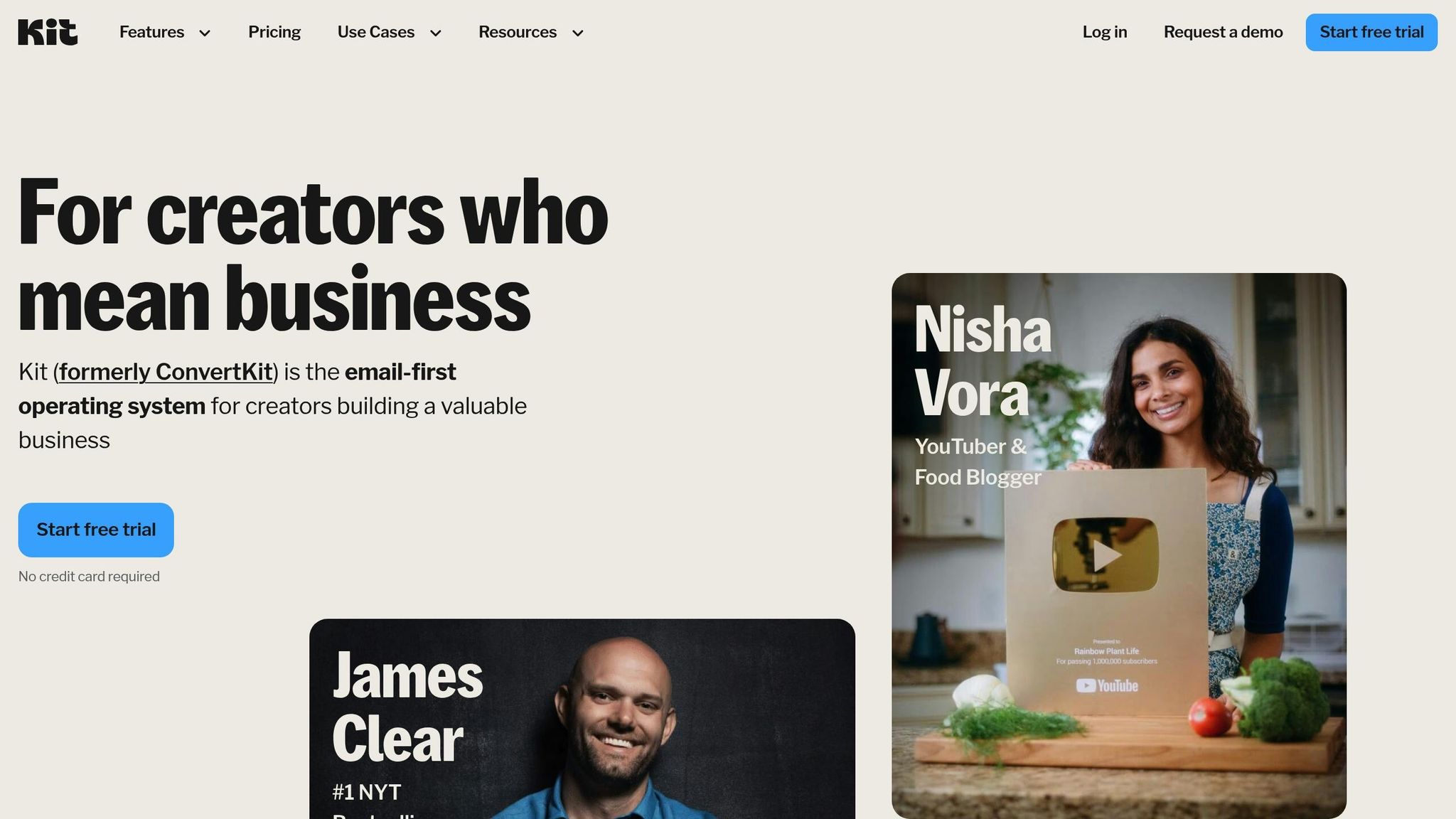
Kit takes a refreshing approach to email marketing by catering specifically to individual creators and small businesses, moving away from the complexities of data-heavy platforms.
Kit is built for creators, bloggers, and online entrepreneurs who value simplicity. It streamlines email marketing with easy-to-use automation tools, helping users build meaningful connections with their audiences.
The platform offers features like visual automation workflows, subscriber tagging, landing page builders, and digital product integrations. These tools are designed for users without technical expertise, making it simple to create targeted and effective email campaigns.
AI Features
Kit integrates automation tools to enhance email campaign management. Its AI-driven features focus on practical, everyday solutions that content creators can use to streamline their workflows and engage their audiences more efficiently.
Pricing
Kit uses a subscriber-based pricing structure that grows with your audience. It includes a free plan with essential tools and tiered paid plans that unlock advanced automation and reporting features. For the latest pricing details, check out Kit’s official website.
Target Users
Kit is tailored for individual creators and small businesses. It’s ideal for bloggers, course creators, authors, podcasters, and small online sellers of digital products. Its creator-first design makes it easy to manage campaigns and build strong audience relationships.
Strengths and Weaknesses
| Strengths | Weaknesses |
|---|---|
| Simple, creator-focused interface | Limited AI tools compared to enterprise-level platforms |
| Easy-to-use visual automation workflows | Basic reporting and analytics capabilities |
| Built-in tools for landing pages and digital products | May not meet the needs of complex or large-scale campaigns |
| Scalable pricing tied to subscriber growth |
Kit stands out as a straightforward email marketing platform, prioritizing ease of use and essential automation. It’s a great fit for creators and small businesses aiming to connect with their audiences without the need for advanced technical skills.
Next, we’ll dive into Rasa’s unique approach to conversational AI in email marketing.
10. Rasa
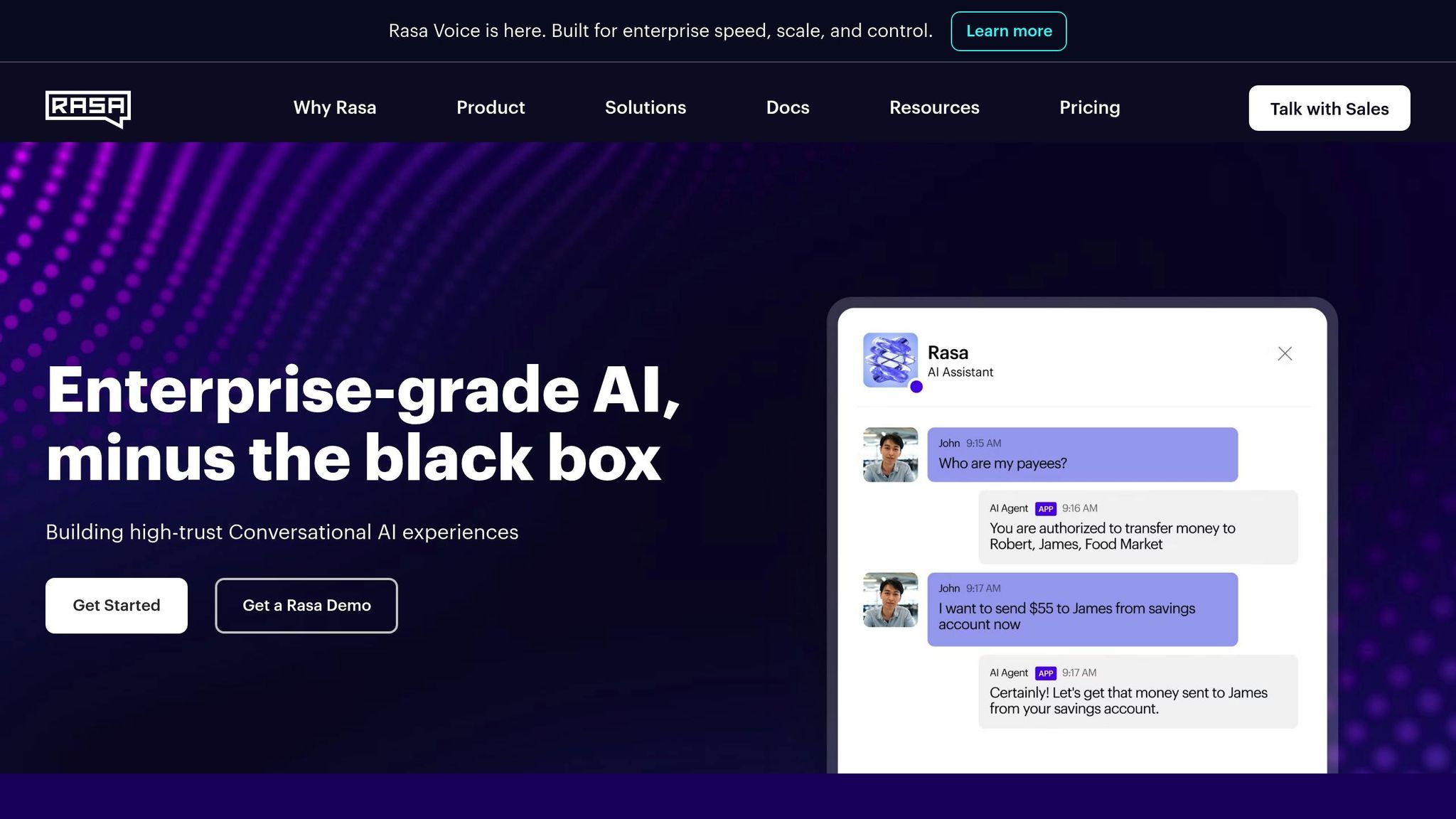
Rasa is an open-source conversational AI framework designed to help businesses create custom chatbots and virtual assistants. While it’s not your typical email marketing tool, Rasa can play a supporting role in email campaigns by managing customer inquiries and boosting engagement.
What sets Rasa apart from traditional platforms focused solely on bulk emails is its ability to build context-aware assistants. These assistants can seamlessly integrate with various communication channels, enhancing broader marketing strategies. This makes Rasa a great choice for organizations aiming to implement tailored, AI-powered communication systems.
AI Features
Rasa uses natural language processing (NLP) to understand user intent and detect key entities. Its dialogue management system is capable of handling complex conversation flows and supports integration across multiple channels. On top of that, Rasa’s AI evolves over time by learning from user interactions, which helps improve the quality and relevance of customer engagements.
Pricing
Rasa follows a freemium model. The core open-source framework is free to use, making it accessible for businesses with technical expertise. For companies needing advanced features, dedicated support, or managed services, Rasa offers enterprise-level solutions with pricing customized to fit specific needs and usage levels.
Target Users
Rasa is best suited for developers, data scientists, and technical teams who want to build custom conversational AI solutions. It’s particularly valuable for enterprises with in-house development teams, SaaS companies looking to streamline customer interactions, and organizations that need highly personalized AI assistants.
Strengths and Weaknesses
| Strengths | Weaknesses |
|---|---|
| Highly customizable and flexible | Requires significant technical expertise to set up |
| Open-source with strong community support | Steep learning curve for non-technical users |
| Advanced natural language processing capabilities | Time-consuming setup and training process |
| Integrates seamlessly with existing communication systems | Limited out-of-the-box features for marketing automation |
| Cost-effective for teams with development resources | May need additional tools for a complete engagement strategy |
Rasa shines as a solution for businesses looking to integrate advanced conversational AI into their customer engagement plans. While its implementation requires technical know-how, the platform’s flexibility allows businesses to create intelligent, context-aware interactions tailored to their needs.
Next, we’ll explore how Mailmodo is reshaping email campaigns with interactive features.
11. Mailmodo
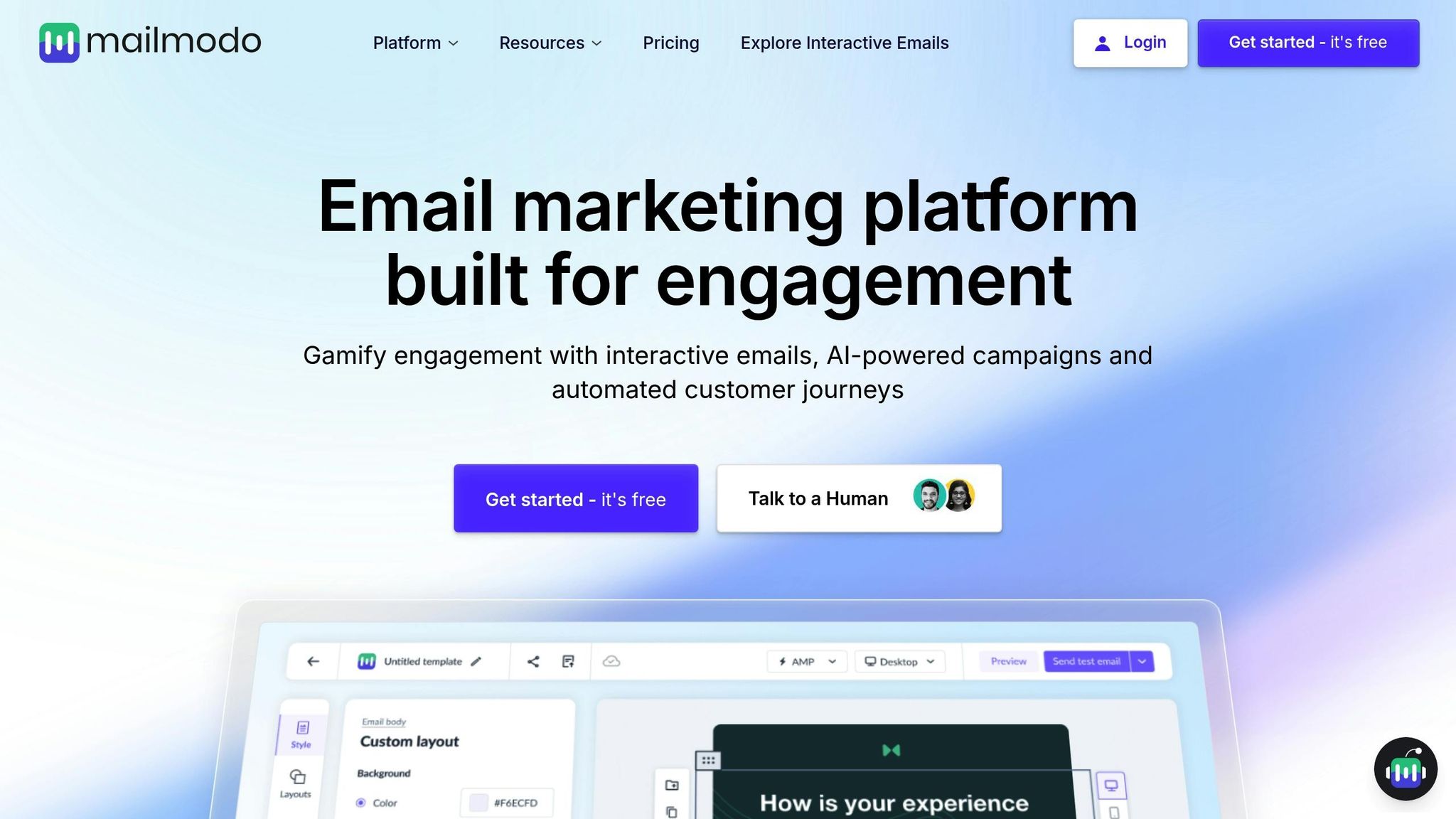
Mailmodo takes email marketing to the next level by introducing interactive in-email elements. Unlike traditional email platforms that require users to click through to external landing pages, Mailmodo lets recipients complete actions - like filling out forms, scheduling appointments, or even making purchases - directly within their email client.
This functionality tackles a common hurdle in email marketing: the gap between clicking and converting. By keeping users within the email, Mailmodo minimizes drop-offs and boosts engagement across campaigns.
AI Features
Mailmodo enhances its interactive email tools with AI-driven personalization and automation. Using machine learning, the platform analyzes user behavior to adjust interactive elements based on recipient preferences and past interactions.
Additionally, its predictive analytics and smart content recommendations ensure emails are fine-tuned to meet campaign goals. This data-driven approach allows businesses to optimize their interactive elements even before hitting "send."
Pricing
Mailmodo uses a tiered subscription model:
- Starter Plan: $39/month for up to 2,500 contacts.
- Growth Plan: $79/month for up to 5,000 contacts, including advanced automation features.
- Enterprise Plan: Custom pricing for larger businesses needing tailored integrations and dedicated support.
All paid plans allow unlimited interactive email sends. A 14-day free trial is available, offering full access to features without requiring a credit card.
Target Users
Mailmodo is ideal for e-commerce businesses, SaaS companies, and marketing agencies looking to drive conversions through direct in-email actions. It’s especially beneficial for organizations that rely on email marketing for lead generation, onboarding, or showcasing products.
Industries like real estate, healthcare, and education - where tasks like form submissions and appointment scheduling are key - can also gain significant value from Mailmodo’s interactive capabilities.
Strengths and Weaknesses
| Strengths | Weaknesses |
|---|---|
| Interactive features compatible with major email clients | Limited template customization compared to traditional platforms |
| Reduces drop-off rates | Learning curve for designing interactive emails |
| Built-in analytics for tracking performance | Higher cost compared to basic email tools |
| No-code editor for creating interactive emails | Some interactive elements may not display consistently across all email clients |
| Integrates well with CRM and e-commerce platforms | Smaller template library focused on interactive designs |
Mailmodo stands out by addressing one of email marketing’s biggest challenges: improving conversion rates through interactivity. While it requires a shift in how businesses approach email design, the platform delivers tangible improvements in engagement and conversion metrics for those ready to embrace this new approach.
Next, we'll explore how Zeta uses AI to deliver highly personalized customer experiences at scale.
12. Zeta
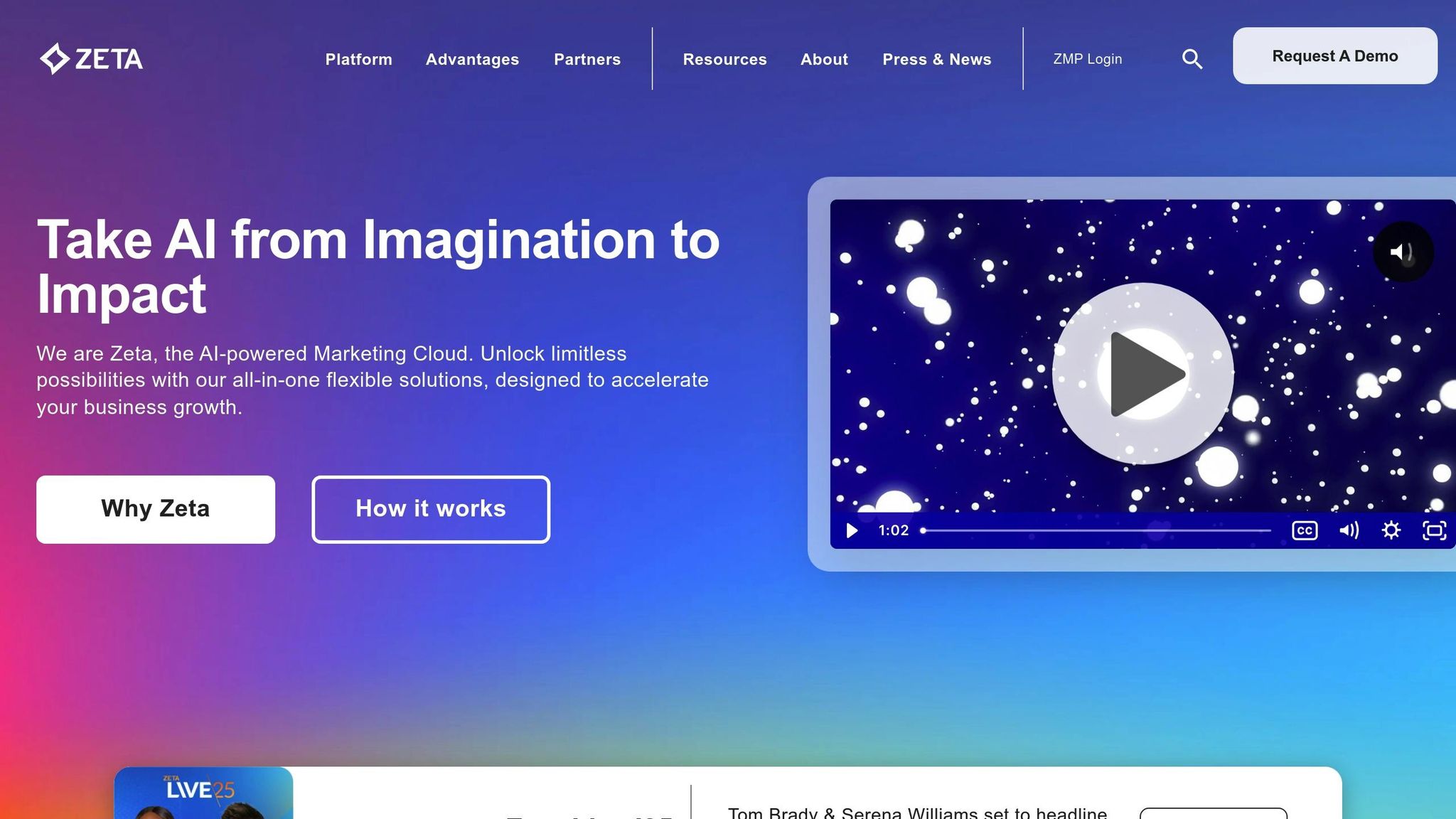
Zeta takes the concept of email marketing to another level by integrating it into a broader marketing ecosystem. Unlike standalone email tools, Zeta is an AI-powered marketing cloud that connects email campaigns with mobile messaging, social media, and web personalization to deliver a unified customer experience. It’s designed to streamline communication across multiple channels, with email marketing as a central element.
What makes Zeta stand out is its ability to combine customer data from various sources and use it to craft highly personalized email experiences. The platform focuses on real-time decision-making, enabling businesses to tweak email content, timing, and delivery based on live customer interactions across all channels. This interconnected approach boosts the overall effectiveness of marketing campaigns.
AI Features
Zeta’s AI-driven tools are built around predictive insights and real-time personalization. By leveraging machine learning, the platform can determine the best time, content, and frequency for each email.
One of its standout features is Dynamic Creative Optimization, which adapts subject lines, images, and call-to-action buttons based on how recipients behave. This goes beyond basic segmentation, incorporating behavioral data, purchase history, and engagement across channels to fine-tune campaigns.
The platform also excels at predicting engagement patterns, such as when customers are likely to respond, and can trigger re-engagement efforts for those at risk of becoming inactive.
Pricing
Zeta offers custom pricing based on the size of your customer database and the features you need. While it doesn’t provide standard pricing tiers, mid-market solutions start at around $2,000 per month. Enterprise packages range between $10,000 and $50,000+ per month, depending on the complexity of the setup and features included. All plans require annual contracts and come with dedicated customer success management.
Target Users
Zeta is tailored for mid-market and enterprise businesses with complex customer journeys and high email volumes. Industries like retail, e-commerce, financial services, and telecommunications benefit most from its ability to coordinate email with other digital channels.
The platform is ideal for businesses managing large customer databases (100,000+ contacts) and those needing advanced segmentation and personalization. However, it’s best suited for organizations with dedicated marketing teams capable of utilizing its advanced features and integrations.
Strengths and Weaknesses
| Strengths | Weaknesses |
|---|---|
| Integrates customer data across multiple channels | High cost may deter smaller businesses |
| Advanced AI for personalization and predictions | Steep learning curve for new users |
| Real-time adjustments to campaigns | Requires long-term annual contracts |
| Seamlessly integrates with enterprise systems | Limited self-service tools for campaign creation |
| Robust analytics and attribution modeling | Overly complex for simpler email needs |
Zeta is a powerful tool for businesses tackling sophisticated marketing challenges, offering seamless integration of email with other digital channels. However, its enterprise-level pricing and technical demands may not be practical for smaller businesses or those with straightforward email marketing needs.
Next, we’ll dive into Jasper, a platform that focuses on AI-powered content creation for email marketing campaigns.
13. Jasper
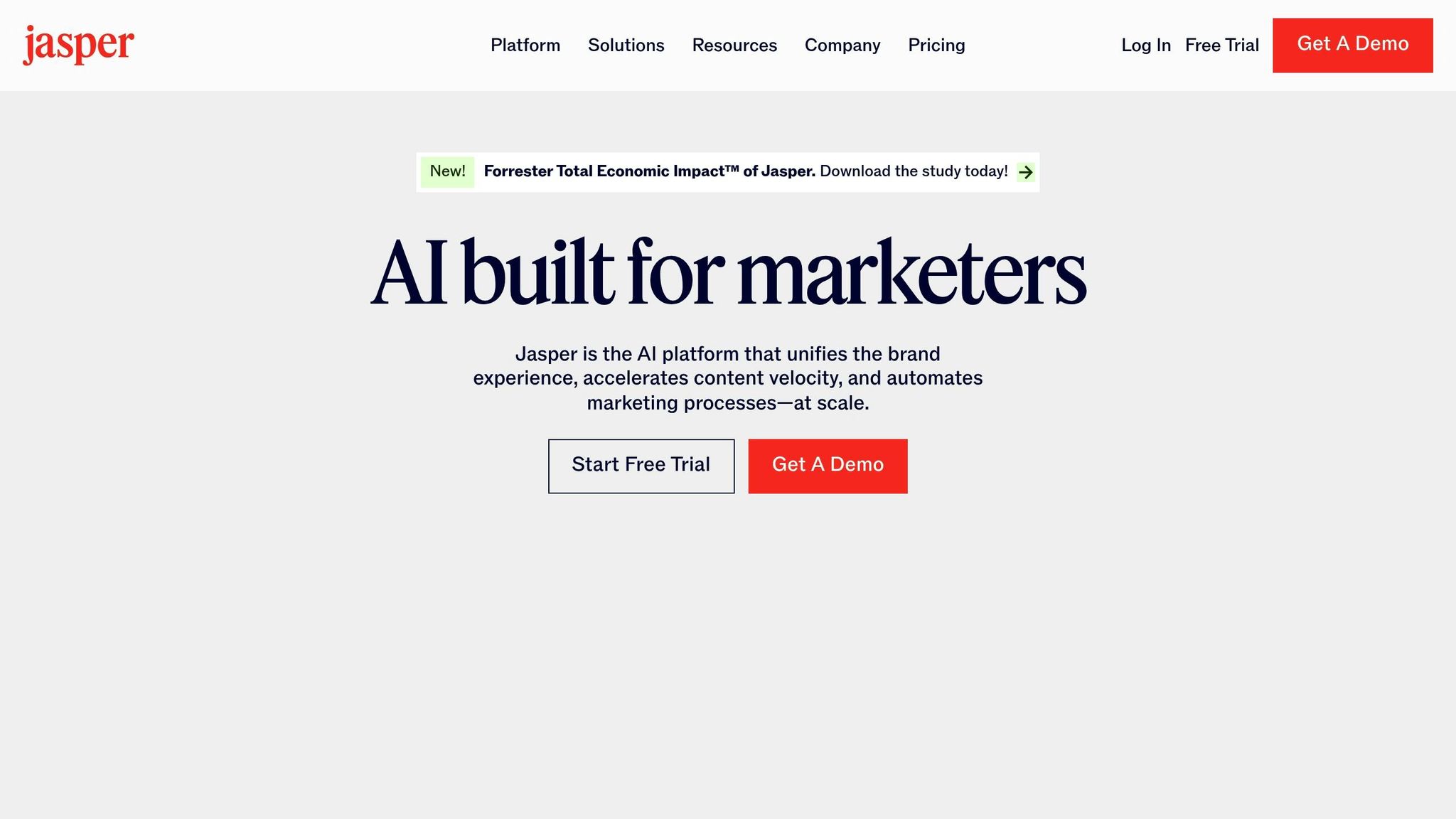
Jasper stands out by focusing on creating persuasive email content, filling the gap where other platforms primarily handle campaign delivery. This AI writing assistant specializes in crafting high-quality, personalized email copy, helping businesses overcome content creation challenges without offering a full email marketing platform.
What sets Jasper apart is its ability to maintain your brand's voice. By learning your tone, style, and messaging from existing materials, it ensures your emails feel genuinely human - perfect for businesses sending emails at scale while keeping quality intact.
AI Features
Powered by GPT-4 and other advanced language models, Jasper excels at understanding context, tone, and persuasion. It comes equipped with specialized templates for various email needs, including welcome sequences, promotional campaigns, newsletters, and re-engagement efforts.
The Boss Mode feature allows users to provide detailed instructions - like specifying the target audience, campaign goals, and tone - to generate complete email sequences. Meanwhile, the Brand Voice training ensures that every email reflects your unique style and messaging.
Pricing
Jasper offers three pricing tiers to suit different needs:
- Creator Plan: $49/month for 50,000 words (around 200–300 emails).
- Teams Plan: $125/month for 100,000 words, supporting up to three users.
- Business Plan: $499/month for unlimited words, advanced collaboration tools, and custom brand voice training.
All plans include pre-built email templates and integrations with popular tools. Opting for an annual subscription saves 20%.
Target Users
Jasper is ideal for content marketing teams, copywriters, and marketing agencies that need to generate large volumes of email content quickly. It’s especially useful for:
- E-commerce businesses running frequent promotions.
- SaaS companies managing complex nurture campaigns.
- Digital marketing agencies juggling multiple client accounts with varying brand voices.
Businesses sending 50 or more emails per month across different campaigns and audience segments will see the most benefit. Companies with dedicated marketing or content teams can easily integrate Jasper into their workflows for maximum efficiency.
Strengths and Weaknesses
| Strengths | Weaknesses |
|---|---|
| High-quality content with consistent brand voice | Requires a separate platform for email delivery |
| Rapid content creation for high-volume campaigns | Steep learning curve for mastering prompts |
| Integrates with popular email tools | Lower-tier plans have word limits |
| Templates tailored to specific email types | Lacks built-in A/B testing and performance analytics |
| Collaboration tools for team use | Pricing may be steep for small businesses with low email needs |
Jasper shines in generating polished, on-brand email content quickly, making it a valuable tool for teams focused on high-volume campaigns. However, it does require integration with an email marketing platform to handle campaign execution.
While Jasper is a powerhouse for content creation, the next platform, Brevo, offers a more comprehensive approach by combining high-quality content with advanced campaign management features.
14. Brevo
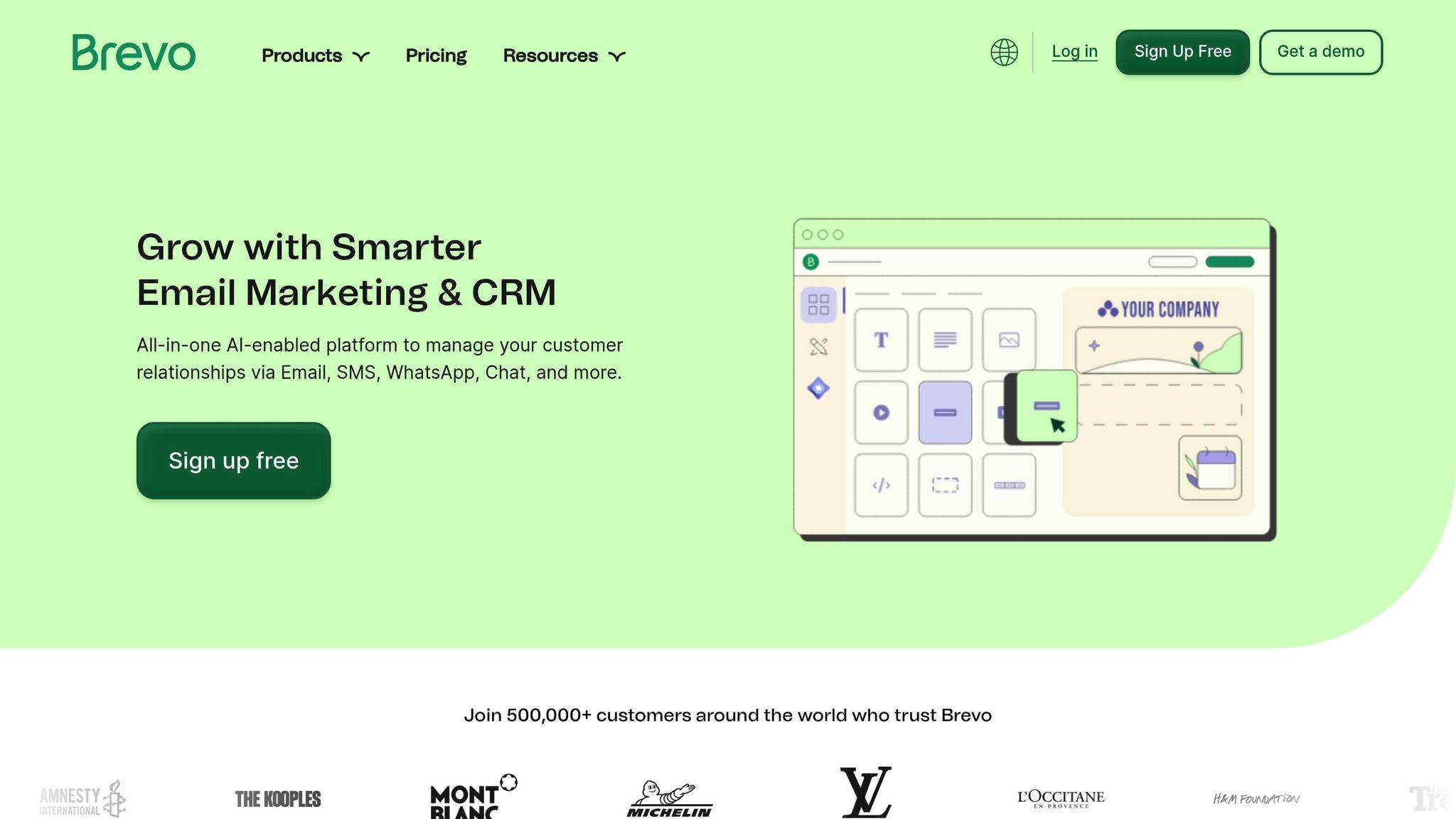
Brevo blends smart automation with an easy-to-use interface to create a robust AI-powered email marketing platform. Previously known as Sendinblue, this tool has grown into a full-fledged marketing suite. It uses machine learning to enhance critical aspects like send times and content personalization, ensuring a tailored experience for users.
While Brevo simplifies complex automation workflows for non-technical users, its capabilities go far beyond standard email marketing. It also supports SMS campaigns, chat features, and CRM integration, giving businesses the ability to manage multiple customer communication channels in one place. This all-in-one setup allows for advanced AI-driven optimizations across various touchpoints.
AI Features
Brevo’s AI analyzes real-time behavior data to determine the best times to send emails, increasing open rates. Its Smart Content feature customizes email elements based on subscriber preferences and past behavior, offering dynamic product recommendations for e-commerce businesses and personalized content suggestions for publishers. Predictive scoring identifies high-potential prospects, enabling marketers to focus on the most valuable leads. The system’s recommendations improve over time as it learns from campaign performance.
Pricing
Brevo operates on a freemium model, making it accessible to businesses of all sizes. The free plan includes a daily email limit along with basic features and branding. Paid plans expand email volume limits, remove branding, and unlock advanced features like enhanced automation and A/B testing. Businesses with variable needs can purchase additional emails or SMS messaging as required. Enterprise-level solutions are also available with custom pricing.
Target Users
Brevo strikes a balance between powerful features and user-friendliness, but its standout SMS, chat, and CRM integration make it particularly appealing. It’s well-suited for:
- E-commerce businesses needing a mix of email and SMS marketing with transactional email capabilities.
- Service-based companies looking for lead-nurturing workflows and tools for client communication.
- Startups aiming to scale their marketing efforts efficiently.
Additionally, its multilingual support and European data centers make it a strong choice for businesses operating internationally.
Strengths and Weaknesses
| Strengths | Weaknesses |
|---|---|
| Generous free plan with email limits | Advanced automation features have some restrictions |
| All-in-one platform with SMS and chat capabilities | Template designs could be more modern |
| High deliverability rates and compliance with European standards | Complex workflows can have a learning curve |
| Affordable pricing with scalable email options | Customer support response time varies by plan |
| Built-in CRM and lead scoring tools | Limited integration options with third-party tools |
Brevo offers a well-rounded suite of marketing tools at competitive prices, making it a great option for businesses looking to manage multiple communication channels in one platform. However, companies seeking highly advanced automation may want to consider other alternatives.
Up next, we’ll dive into Encharge’s behavior-driven automation.
15. Encharge
Encharge uses behavior-driven automation to track user actions across websites, apps, and emails, triggering highly targeted messaging sequences. Unlike traditional email platforms that rely mostly on demographic data, Encharge builds detailed behavioral profiles. It automatically tags users based on their actual actions, aligning perfectly with the idea of using AI for precision targeting.
What sets Encharge apart is its ability to connect different customer interactions seamlessly. For example, if a user visits a pricing page, downloads a resource, or abandons their shopping cart, the platform tags them automatically. This behavioral insight is especially valuable for SaaS companies and e-commerce businesses that need to guide leads through complex sales funnels.
AI Features
Encharge's AI tools analyze user behavior to predict the best next steps. The platform automatically segments users based on their engagement history, website activity, and how they interact with products. Its Flow Builder applies machine learning to suggest email sequences based on data from past campaigns, making it easier to create personalized and automated workflows.
The Smart Segments feature updates subscriber lists in real time as user behaviors change, ensuring messages always reach the right audience. Encharge also offers AI-powered send time optimization, which determines the best time to email each subscriber based on their activity patterns. Additionally, its predictive analytics highlight users likely to churn or convert, enabling marketers to take action with targeted campaigns at critical moments.
Pricing
Encharge uses a subscriber-based pricing model, starting at $79 per month for up to 1,000 contacts. As your contact list grows, the pricing scales - $299 per month for 10,000 contacts and $599 per month for 25,000 contacts. All plans include unlimited email sends, advanced automation tools, and behavioral tracking.
A 14-day free trial is available, and no credit card is required to get started. However, there’s no permanent free plan, reinforcing the platform’s position as a premium solution for businesses focused on behavior-driven marketing. For larger organizations with custom needs, enterprise pricing is also available.
Target Users
Encharge is best suited for businesses with complex customer journeys that require advanced behavioral tracking. This includes SaaS companies, e-commerce businesses, digital agencies, and B2B organizations with longer sales cycles that demand detailed lead nurturing.
The platform is ideal for marketing teams experienced in automation, as beginners may find it challenging to navigate.
Strengths and Weaknesses
| Strengths | Weaknesses |
|---|---|
| Advanced behavioral tracking and segmentation | Steep learning curve |
| Robust automation workflows with conditional logic | No free plan offered |
| Real-time behavioral triggers and tagging | Limited template design options |
| Comprehensive analytics and reporting | Pricing may be high for smaller businesses |
| Technical setup required for advanced features |
Encharge is a powerful tool for marketers ready to move beyond basic email campaigns and embrace behavior-driven marketing. While it demands a greater investment of time and money, its automation capabilities can greatly enhance engagement and conversion rates for businesses that can maximize its potential.
Tool Comparison: Pros and Cons
Picking the right AI email marketing tool boils down to understanding your business needs, budget, and technical skills. Each platform has its strengths, but also some drawbacks that could influence your marketing strategy.
For budget-conscious users, Mailchimp and MailerLite stand out with their free plans, though their AI features are more basic compared to premium options. Brevo is another solid choice, offering 300 free daily emails - perfect for startups experimenting with email marketing.
Enterprise-level organizations looking for advanced automation should explore platforms like ActiveCampaign, Optimove, or Encharge. These tools shine in behavioral tracking and handling complex workflows but come with higher costs and require more technical expertise.
For content creators and agencies, Jasper is a go-to for AI writing. However, since it doesn’t handle list management or automation, pairing it with platforms like GetResponse or Kit can create a seamless content creation and delivery setup.
E-commerce businesses might find Mailmodo and Constant Contact particularly useful. Mailmodo offers interactive email features, while Constant Contact provides retail-focused templates, product recommendation engines, and abandoned cart recovery sequences.
Here’s a quick comparison table for easy reference:
| Tool | Starting Price | Free Plan | Best AI Feature | Ideal For | Limitation |
|---|---|---|---|---|---|
| AI Apps | Free | Yes | Tool discovery & comparison | Finding AI tools | Not an email platform |
| Mailchimp | Free | Yes (2,000 contacts) | Predictive demographics | Small businesses | Limited automation on free plan |
| ActiveCampaign | $29/month | No | Behavioral automation | Advanced marketers | Steep learning curve |
| Encharge | $79/month | No | Behavioral tracking | SaaS companies | No free plan |
| Jasper | $39/month | No | Content generation | Content creators | No email delivery |
| MailerLite | Free | Yes (1,000 contacts) | Smart segmentation | Beginners | Basic AI features |
| Brevo | Free | Yes (300 emails/day) | Send time optimization | Startups | Limited free sends |
| GetResponse | $19/month | No | Conversion optimization | E-commerce | Complex interface |
Beyond pricing and features, platforms differ in complexity and integrations. MailerLite and Kit are beginner-friendly, ideal for solo entrepreneurs without a dedicated marketing team. On the other hand, Rasa offers unlimited customization but requires programming skills. Twilio SendGrid and Zeta excel in API connectivity, making them great for integrating with CRM systems and e-commerce platforms.
Scalability is another factor to weigh as your business grows. While free plans help startups get started, costs can rise quickly with contact-based pricing. Constant Contact and GetResponse offer predictable pricing models, while Optimove provides custom pricing for enterprise-grade scalability.
When it comes to AI capabilities, platforms vary significantly. Optimove and Encharge use machine learning for predictive analytics, while Mailchimp focuses on simpler automation triggers. Customer support also differs: Constant Contact includes phone support on all plans, while Kit provides extensive educational resources.
If you’re balancing price and features, MailerLite offers excellent value with advanced automation at a budget-friendly price. Encharge, while more expensive, justifies its cost with sophisticated behavioral tracking. Meanwhile, AI Apps takes a different approach, helping businesses compare and find the right tools instead of offering email marketing services.
Most platforms perform well in mobile optimization and deliverability rates, but Twilio SendGrid and Mailchimp have slight edges due to their strong sender reputations and robust infrastructure.
Conclusion
Automation and machine learning have become essential in email marketing. As highlighted in our review of these 15 tools, the success of your campaigns hinges on selecting platforms that align with your business model, technical know-how, and growth objectives. These tools are constantly evolving, making it crucial to choose one that meets your specific needs.
When deciding, budget and scalability often take center stage. For startups, free plans offered by Mailchimp and MailerLite provide a solid starting point. However, businesses aiming for rapid growth may find platforms like ActiveCampaign or Encharge more suitable, thanks to their advanced behavioral tracking features and higher contact limits.
It’s worth noting that having more AI features doesn’t automatically translate to better results. Success comes down to execution and strategy, not just the technology itself. The tools reviewed here demonstrate that effective email marketing involves aligning the platform's capabilities with your business goals, rather than relying solely on AI sophistication.
Integration capabilities are also becoming increasingly vital as businesses adopt diverse tech stacks. Platforms like Twilio SendGrid and Zeta stand out for their strong API connectivity, making them ideal for companies with established systems. On the other hand, Rasa offers extensive customization for organizations with the technical expertise to leverage it, although this flexibility requires a deeper level of development knowledge.
A clear trend across the industry is the shift toward behavior-driven marketing. Tools such as Encharge and Mailmodo are leading the way by moving beyond simple demographic segmentation. They focus on real-time behavioral triggers and interactive email experiences, encouraging marketers to think more strategically about customer journeys and data collection.
For businesses feeling overwhelmed by the sheer number of options, platforms like AI Apps offer a solution. With a curated directory of over 1,000 AI tools, AI Apps provides advanced filtering and comparison features, making it easier to find email marketing solutions tailored to your needs and budget.
Looking ahead, the future of AI in email marketing is steering toward greater personalization and automation. However, the key to success will always lie in understanding your audience and delivering messages that resonate. Whether you opt for a straightforward tool like MailerLite or a feature-rich platform like ActiveCampaign, the ultimate goal is to consistently provide value to your subscribers. By aligning your strategy with the strengths of the right tool, you can ensure your email campaigns stay as dynamic and effective as the technology driving them.
FAQs
How can AI tools improve personalization and engagement in email marketing campaigns?
AI tools bring a new level of personalization to email marketing by crafting content that aligns with each recipient's behavior, preferences, and past interactions. This makes emails feel more relevant and engaging, which naturally increases the chances of a positive response.
Beyond personalization, these tools handle tasks like audience segmentation and generating tailored messages automatically. This allows marketers to create emails that connect with specific groups on a deeper level. The result? Higher open rates, better click-through rates, and more effective campaigns overall - all while building stronger customer relationships.
What should businesses look for when choosing an AI email marketing tool?
When choosing an AI-powered email marketing tool, it's essential to focus on features that match your business objectives. Look for tools with automation capabilities, personalization features, and audience segmentation to streamline your campaigns. Advanced AI-driven features, such as send-time optimization, subject line recommendations, and performance analytics, can make a big difference in how effectively your emails resonate with your audience.
Equally important is ensuring the tool works smoothly with your current CRM or marketing platforms. To gauge its reliability and potential impact, take time to explore customer reviews, case studies, and the vendor’s track record in the industry. These insights can help you make a more informed decision.
Can AI email marketing tools work with my CRM or e-commerce platform, and what are the benefits?
Yes, AI email marketing tools can easily connect with your CRM and e-commerce platforms. These integrations make it possible to automate key tasks like syncing data, segmenting customers, and tracking campaign performance.
When these tools work together, businesses can send personalized email campaigns that align with each customer's behavior and preferences. The benefits? Stronger customer engagement, more precise targeting, and improved marketing efficiency. In turn, this leads to smoother workflows, higher customer retention, and greater revenue potential.

